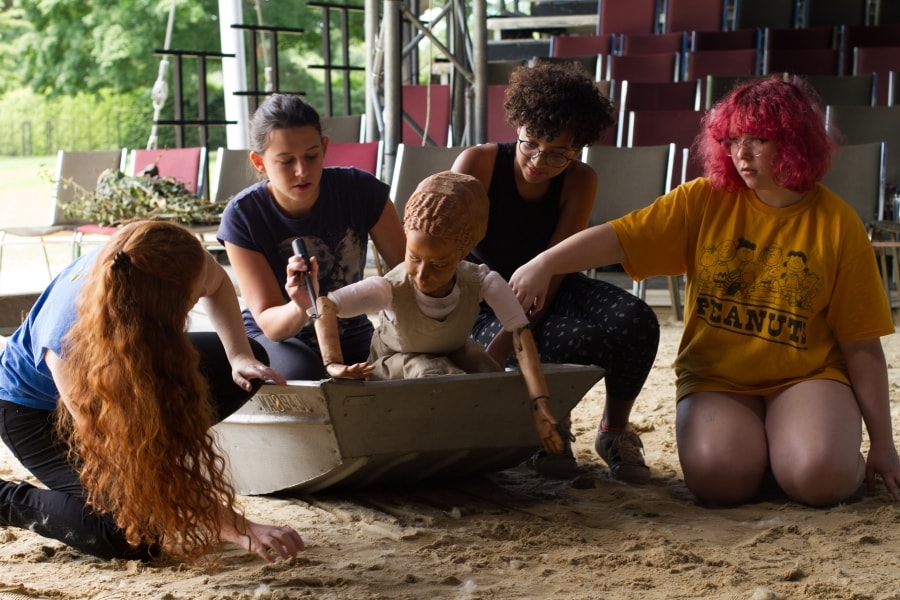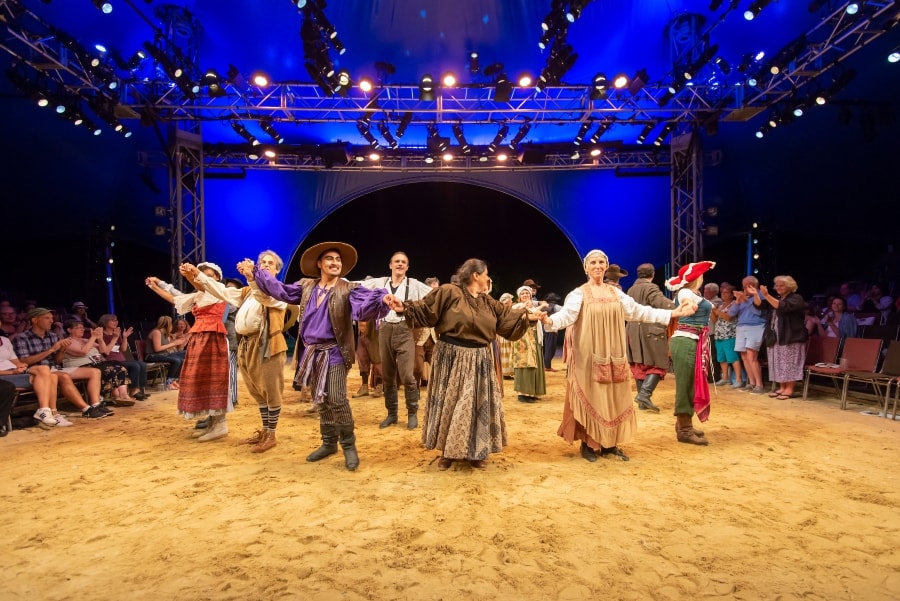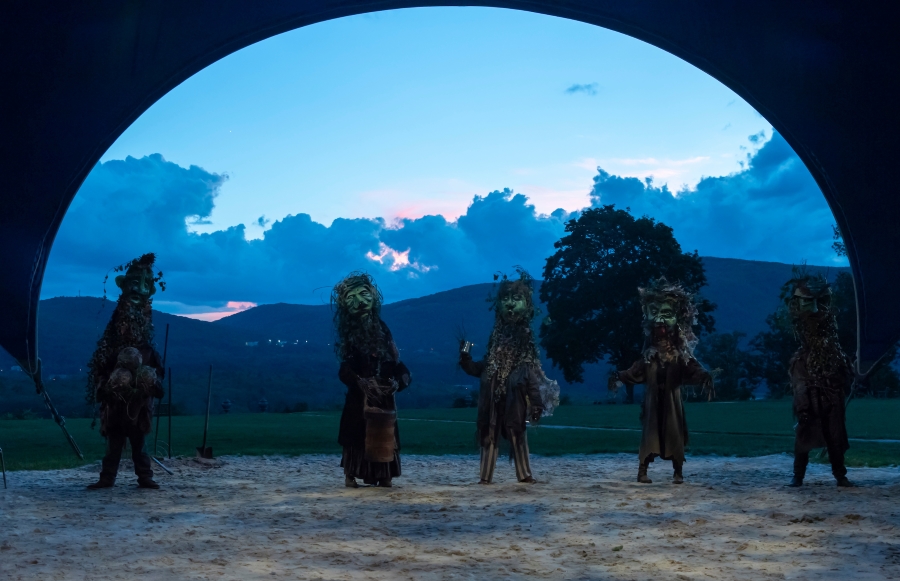The Hudson Valley Shakespeare Festival (HVSF) is a summer affair in Garrison, N.Y. Performances take place under a large tent on the grounds of the historic Boscobel House and Gardens, and audience members are invited to picnic on the lawn before shows. The performance site always makes an idyllic backdrop, but its sweeping view of the Hudson River could have been expressly designed for the company’s recent production of Rip Van Winkle, which ran Aug. 31-Sept. 3.
Rip Van Winkle was part of HVSF’s Full Circle program, a community engagement project that aims to bring Hudson Valley residents into the fold of the theatre’s programming, beyond simply inviting them to a picnic and a show. The company’s first Full Circle project was Our Town in 2016, but the setting of the Catskills mountains in Rip Van Winkle hit much closer to home than Grover’s Corners.
“We wanted to do a play that was deeply connected to this place, the Hudson Valley, and that is what led us to commission Rip Van Winkle from Seth Bockley,” said Davis McCallum, artistic director of HVSF.
Bockley’s fantastical literary adaptation brought Washington Irving’s folktale, about a man who disappears into the Catskill Mountains and falls into a 20-year slumber, up to the present, with buccaneers, fantastical spirits, and the people who inhabit the Hudson Valley today. The tale, originally penned 200 years ago this summer, is among other things a love letter of sorts to the land and those who inhabit it.
“There was a desire to acknowledge and be grateful to the community that had really nurtured and supported this festival that had grown from a very DIY operation in the beginning to a big flagship cultural institution in the Hudson Valley,” said Elizabeth Audley, the company’s new director of community engagement, who was brought on just in time to steer the Rip Van Winkle project.
The yearlong process of making the play, the company’s first commissioned work for the mainstage, really “set everybody in the community on fire,” Audley said. Textile artisans and painters and woodworkers lent their talents to build set pieces and stitch costumes, a local choreographer (Belle Ritter) came on board, and of course, local residents performed as part of the show.
Audley led the charge of finding community partners throughout the sprawling Hudson Valley for workshops, rehearsals, and outings, including a day at Irving’s estate 36 miles south of Hudson Valley Shakespeare Festival for a special tour and potluck picnic. It was at these storytelling workshops that the Rip Van Winkle project found its 42-person cast.

At a rehearsal in early August, Bockley, who would direct as well as write, began the session with an exuberant, “Let’s play!” A circle of community members ebbed and flowed around the room, imagining their bodies as currents of water and fish swimming in a school. One cast member shared her experience of having swam across the Hudson the week prior, comparing the underwater feeling to being swished through a dishwasher.
The community members, who live and breathe and even swim in the Hudson Valley, were an integral part of the development process of the play.
“The show is exciting because, by virtue of being a new play, it has a certain amount of elasticity to it, and we can take a certain freedom with making the play fit to the people who are in it and shape it around the people who are doing it,” said Audley.
Accordion players and flutists joined the band. A pair of clowns who recently moved to the Hudson Valley from Colombia joined the cast and led the rehearsal warm-ups with Spanish songs.
But the best example of “people who just showed up and became central to the structure and the dramaturgy of the play,” as McCallum put it, were four young women who operated the puppet of Sarah Van Winkle, Rip’s daughter, who goes on a quest to find her snoozing father. These teen puppeteers did not know each other before the project, nor did they know how to work with puppets when they began. “In a story about transformation from this young Sarah to a woman, to watch those four young women become a group over the summer has been really rewarding,” says McCallum.

While the Full Circle project was inspired in part by the Public Theater’s Public Works program, the geographic location of the Hudson Valley posed certain challenges.
“The Delacorte is in Central Park, which is a place I think all New York City residents feel belongs to them,” said McCallum. “It is already marked as a very democratic public space, but the Hudson Valley is a much more disparate geography. When your community is so geographically widespread, where is your meeting space? How do you define that in a way that it doesn’t reinforce already existing systems of privilege but makes it open to everyone?”
To combat the lack of public transportation for the participants—who were from as far north as Newburgh and as far south as Tarrytown—the workshops, rehearsals, and even performances were spread across the valley; one show took place at the University Settlement Camp in Beacon. The tickets, which were free, were distributed at various businesses to neighbors and to community partners throughout the summer.
On the second day of the performances at HVSF’s tent, the Colombian clown duo wove through the picnic blankets, inciting laughter and singing songs before the show. Shortly after, the tent filled with chatter as excited audience members flipped through the program, finding friends, family members, and neighbors in the credits.
“What you’re about to see is, I think, a really excellent piece of art, but it’s also something bigger than that,” said McCallum before the show. “It is a proposal about what it looks like when instead of being entrenched and isolated, we are coming together sort of E pluribus unum style. That’s important because it shows that we are serious about our mission, which is to engage the widest possible audience in a conversation, and it also manifests our belief that creativity is not the special providence of the professional artist, it is something intrinsic, something that makes us human, and it is something we all share.”
In one scene Rip Van Winkle comes upon a group of demons in the forest—the tree creatures who give him the infamous magical cider that spurs his decades-long nap. The towering demons play a game of nine pins, and the bowling ball rumbles and creates thunder through the mountains. Soon after, booms reverberated outside the tent—fireworks sparkled across the river at the United States Military Academy in West Point. The stage manager announced on the God mic that the show would be paused for the fireworks, and the cast and audience fled to the field to admire the Labor Day celebration in the sky, E pluribus unum style.
McCallum summed up the whirlwind performance weekend much like sleeping Rip Van Winkle might: “Was that a dream?”
But the connectivity of the new-formed friendships among the cast and community will continue with potluck dinners and gatherings—Our Town cast members still meet up—and the company will continue to find ways to bring the community together outside of its summer theatrical fare.
“There is a desire, on our behalf, to be something more of a year-round cultural hub and presence for the community, both with our education programs and our community programs,” said Audley.
You might even say that the theatre and the community are awake to each other like never before.
Hudson Valley Shakespeare Festival presented Rip Van Winkle, written and directed by Seth Bockley with scenic designer Sandra Goldmark, costume designer Charlotte Palmer-Lane, lighting designer Mike Inwood, sound designer Pornchanok Kanchanabanca, composer and music director Raymond Bokhour, choreographer Belle Ritter, production stage manager Avery Trunko, assistant director Myeongsik Jang, associate producers Elizabeth Audley and Paloma Wake, puppet designer Jesse Mooney-Bullock, scenic associate and props designer Buffy Cardoza, voice and text coach Alithea Phillips, assistant to the director Casey Morris, and assistant stage manager Sara Kadish.


